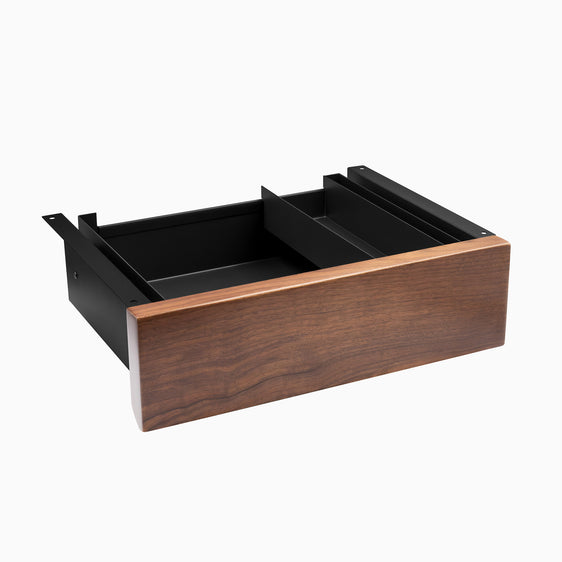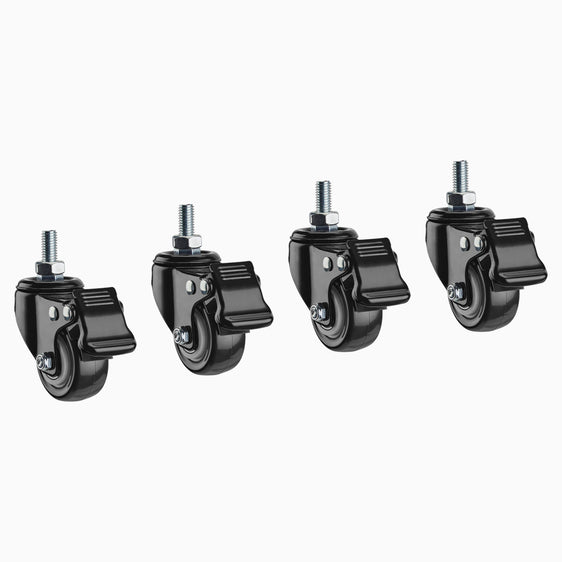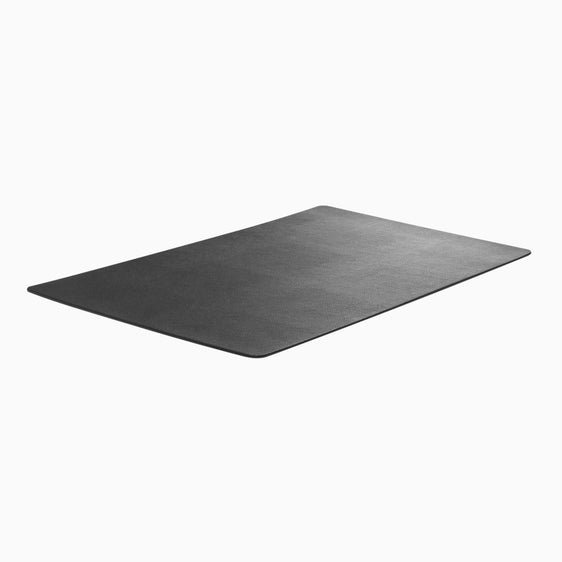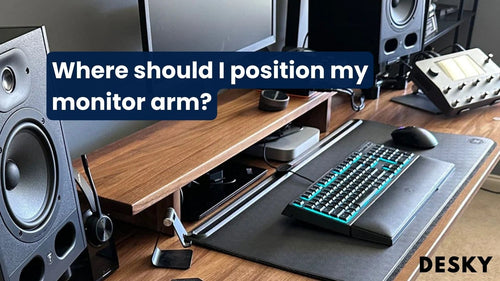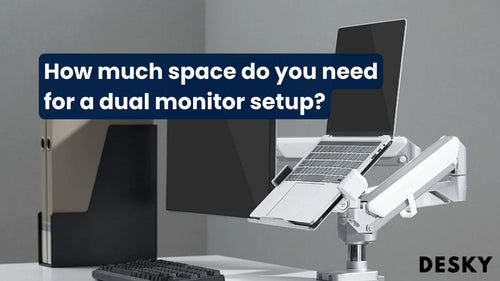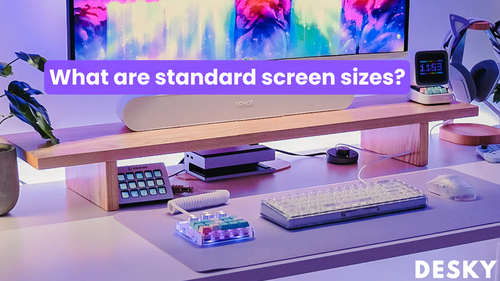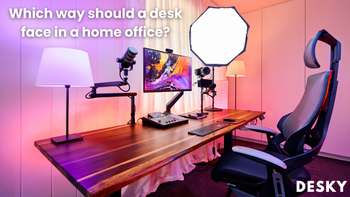
FAQ
Which way should a desk face in a home office?
Hayden AdamsUnderstanding the best positioning of a desk in your home office can dramatically enhance productivity, comfort, and satisfaction in your workday. As the leading specialist in ergonomic office furniture, we at Desky will unveil the most optimal arrangements for your work area.
Best Placement In A Traditional Office Setting
For best placement within a conventional office, adopting the principles of Feng Shui could be beneficial. Your office desk should adopt the "command position", such as the placement of our Corner Standing Desks | L-Shaped Sit Stand Desks, with the desk facing, but not directly aligned with, the doorway.
This position denotes authority and minimizes the element of surprise, enabling you to visualize anyone entering the office.
- Position the desk to face the door without direct alignment
- Maintain a clear view of anyone entering the office
Arranging Desks in a Small Office
Positioning the desk centrally in the workspace creates a flow within the room, fostering easier mobility. If the desk has to be against the wall, try arranging visitor chairs in accessible areas rather than cramming them against a wall. Keeping wall areas clear gives an illusion of a larger space and prevents the room from appearing stuffed.
Accommodating Three Desks In A Compact Office
For three desks, consider adopting a U-shaped desk layout where each desk sits against a wall, creating an open U facing the office entrance or window. Such an arrangement maximises the floor area and ensures each user has a personal workspace.
Fitting Two Desks In Diminutive Office
When dealing with two desks, adopt a face-to-face arrangement in the room's heart, creating an island surrounded by an open area for storage or even a breakaway couch.
Should face-to-face positioning be too distracting, inserting a privacy divider between the desks could alleviate this issue. Back-to-back positioning can also offer additional personal space.
{{ spec_dual_hardwood_desk }}
How To Maximize Space in a Diminutive Office
Making the most of the space in a petite office can seem daunting. Prioritize multi-functional furniture like desks with integrated storage or seating with built-in filing. Ensure efficient use of vertical spaces by installing shelves or hanging organizers.
Keep the floor clear by minimizing under-desk clutter and consider wall- or ceiling-mounted lighting instead of freestanding lamps.
Desk Arrangement For Home Office

The ideal placement of a desk in a home office undoubtedly hinges on proximity to natural light. Position your desk near a natural light source, ideally close to a window.
However, should this result in distraction, configuring your desk perpendicular to the window can do wonders for productivity levels.
Desk Direction For A Home Office Desk
According to Vastu, the most propitious direction to place your work desk at home would be towards the south, west, or southwest. Concurrently, your desk should angle itself to ensure you face northeast while working.
This setup facilitates for uninterrupted sunlight to stream in, uplifting the workspace and keeping you revitalized. Key points in these aspects of the desk direction include:
- Orient the desk southwards, westwards, or to the southwest
- Ensure you face northeast when seated
- Position the desk to allow sunlight to permeate the workspace
Desk Facing Window Or Wall
While a scenic window view can be inviting, most design experts suggest that placing the desk against the window, centered within the room, and oriented towards the entrance, can prove advantageous.
A desk like our Desky Dual Rubberwood Sit Stand Desk would work perfectly with this arrangement as it facilitates easier view of anyone who enters or leaves the office whilst mitigating distractions from the exterior world.
Where To Put A Desk With No Space
Being strategic about space use is key when dealing with minimal surfaces. Transforming corners into office spots, leveraging vertical space, and utilising overlooked spaces like under the staircase can miraculously accommodate that essential desk. One of the best ways is by using a corner standing desk that fits neatly into corners, providing efficiency without eating up too much space.
Where do you put an office when you don't have a spare room?
Search out unused spaces within the home and repurpose them; for example, a hallway nook or a window bay can be converted into a compact workstation.
Frequently overlooked areas such as a landing, the space beneath stairs, or even a large closet can offer ample room for a sizeable desk and seating.
{{ spec_dual_mini_desk }}
Desk Arrangement For Small Apartment
For those grappling with the challenge of accommodating a desk in a tiny apartment, space optimization is crucial. Your strategy should consist of furniture that can be folded, stacked, or dismantled when not in use.
Wall-mounted or floating desks are a favored solution for many owing to their negligible footprint - these desks can simply be folded back into the wall when you're done.
Another space-saving marvel, convertible desks, can foot the bill too; they can metamorphose into a coffee table or a dining table as needed. Desky Dual Mini Sit Stand Desk can be a perfect fit for such settings, providing flexibility and ease of use.
How To Hide Desk In Small Apartment
When it's necessary to hide your desk, you can do so cleverly without sacrificing functionality. Cabinets that morph into desks or console-table desks are good examples.
These offer the perfect illusion of a classical piece of furniture, yet quickly transition into a functional workspace. Similarly, a desk hidden underneath an elevated bed or behind a sofa can also keep your workspace out of sight until needed.
Where should a desk be placed in an apartment?
The placement of your desk can further improve your utilization of space. A corner desk is an excellent choice here. Wrapping around the side of your bed, it extends to the adjacent wall, providing ample room for your work requirements.
You can also consider utilizing the vertical space by installing parallel shelves that ascend towards the ceiling. Respecting your budget constraints, you might consider investing in an overbed desk for extreme space optimization. Not only does it offer a sizeable workspace, but it also doesn't compromise on floor area.
How To Hide Desk When Not In Use
Several creative methods exist to keep your desk under the radar when out of operation. Consider integrating it with existing furniture. How about a bookcase, or a chic sofa? Those furnishings create concealment and serve double-duty in your apartment.
Ample living spaces benefit from a discrete room divider, veiling your workstation and providing you with a unique, private working area. Embellish your space with ornamental items like a flourishing plant, to draw eyes away from your desk.
How To Deal With Small Desk Space
Once you've managed to accommodate a desk, ensuring efficient use of the desk space becomes key. Large items such as files or notebooks should be kept on top.
Below could reside small containers housing miscellaneous items like paper clips, binder clips, etc. Desk organizers prove helpful to fully utilize the vertical space which might otherwise go unused. Some of these organizers also feature drawers for added storage convenience.
Conclusion
Optimizing desk positioning within your home office fundamentally can augment productivity, work efficiency, and general satisfaction.
Whether adhering to the principles of Vastu or Feng Shui, positioning towards a natural light source, or determining whether to face the window or the wall, manifold factors contribute to creating the perfect workspace.
Tailoring these elements to your unique needs will ensure that you experience the joy and satisfaction of working in a well-designed and ergonomically optimized home office.
Choose Desky for comprehensive ergonomic office solutions that champion both your wellness and work efficiency. From optimal desk placement advice to high-quality office furniture, we have you covered.


